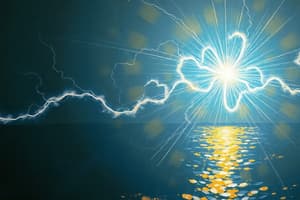Podcast
Questions and Answers
What does Ohm's law describe?
What does Ohm's law describe?
- The relationship between voltage and resistance only
- The relationship between voltage and current only
- The relationship between resistance and current only
- The relationship between voltage, current, and resistance (correct)
What is the unit of resistance?
What is the unit of resistance?
- Volt
- Ampere
- Watt
- Ohm (correct)
If the voltage across a resistor is doubled, what happens to the current if the resistance remains constant?
If the voltage across a resistor is doubled, what happens to the current if the resistance remains constant?
- It halves
- It doubles (correct)
- It remains the same
- It quadruples
Flashcards
Ohm's Law
Ohm's Law
Describes the relationship between voltage, current, and resistance in an electrical circuit.
Ohm
Ohm
The standard unit of electrical resistance, representing the opposition to the flow of current.
Voltage Doubled, Constant Resistance
Voltage Doubled, Constant Resistance
The current doubles if resistance remains constant, according to Ohm's Law.
Study Notes
Ohm's Law
- Ohm's law describes the relationship between voltage, current, and resistance in a conductor.
- It states that the current flowing through a conductor is directly proportional to the voltage applied across it, and inversely proportional to the resistance of the conductor.
Resistance
- The unit of resistance is the Ohm (Ω).
Effect of Voltage on Current
- If the voltage across a resistor is doubled, the current flowing through it will also double, provided the resistance remains constant.
Studying That Suits You
Use AI to generate personalized quizzes and flashcards to suit your learning preferences.




